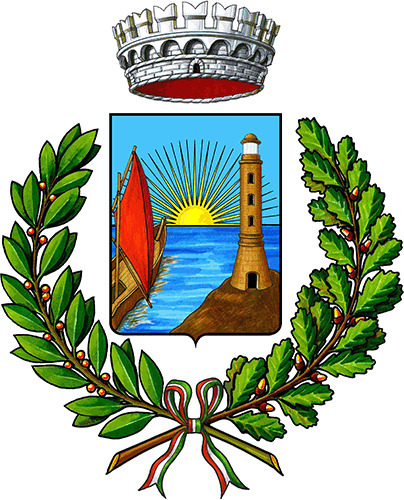
Porto Canale e Colonne Bizantine
Il Porto Canale di Cesenativo venne realizzato su progetto di Leonardo da Vinci nel 1502 su commissione di Cesare Borgia.
All'imbocco del ponte ecco stagliarsi le due colonne bizantine in granito rosa, tuttora presenti accompagnate dalle barche storiche e dai simboli celati dietro ai drappi colorati delle vele. Le colonne risalgono al breve periodo di dominazione Veneziana (1503-1505) e come usanza avrebbero dovuto reggere una il leone di San Marco e la seconda la statua del patrono locale.

Contributi fotografici da Wikipedia, Forlì24ore.it, Livingcesenatico.it, Istituto italiano Edizioni Atlas.
Durante il Rinascimento l'importanza del porto di Cesenatico crebbe soprattutto nel breve periodo della dominazione della Serenissima Repubblica di Venezia, quando il piccolo centro divenne un importante nodo di scambi internazionali, specialmente con le Fiandre e la Spagna, e le colonne ad oggi sono ancora li a testimonianza di questo incredibile passato di Cesenatico.
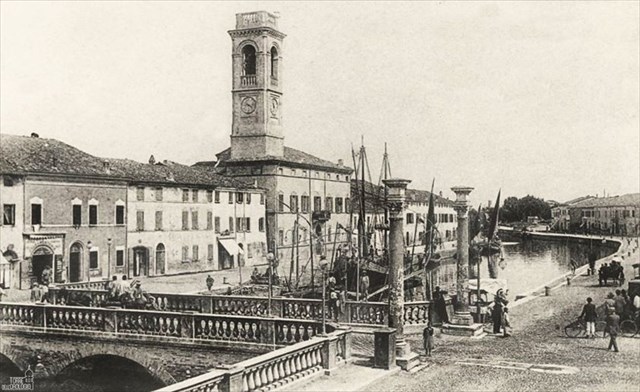
Il Granito
Il granito in generale è una delle rocce più abbondanti sulla superficie terrestre; si tratta di una roccia ignea intrusiva felsica, quindi formata a seguito della lenta solidificazione di un magma che si è intruso a profondità comprese tra 1,5 e 50 km. Il colore è molto variabile e legato principalmente al colore del feldspato potassico e al contenuto dei minerali femici: bianco, giallo, rosa, rosso, bruno e verde.
Il processo di formazione del granito, al sua genesi è tuttora in fase di dibattito ed ha generato varie ipotesi (Genesi per cristallizzazione frazionata o per ultrametamorfismo) e classificazioni dei graniti (come classificazione Alfabetica, di Pitcher o di Pearce).
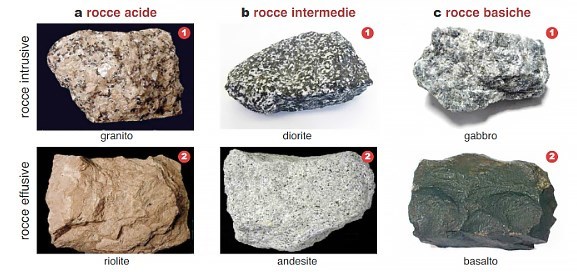
E’ una roccia formata per la maggior parte da feldspati, quarzo e miche (un gruppo di minerali appartenente ai fillosilicati) e la tessitura è faneritica ipidiomorfa, da equigranulare a porfirica. Nel caso del marmo rosa di queste colonne vi è una buona presenza di xenoliti intrusivi composti da minerali femici, miche nere la cui colorazione è data dalla la presenza di Ferro.
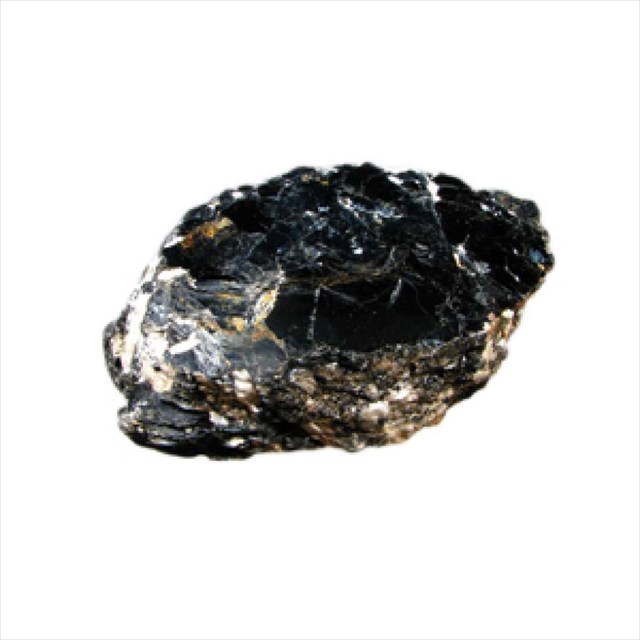
La "grana"
Il granito, dal latino granum (a grani), come il nome sugerisce fa chiaro riferimento alla sua tessitura granulare o faneritica. L'origine del nome viene attribuita a Andrea Cesalpino, filosofo, botanico e professore universitario (1520–1603). La sua grana va da media (circa 1 mm) a grossolana (circa dai 4mm in su) e occasionalmente può presentare megacristalli come gia detto nel caso del marmo rosa di queste colonne e delle miche nere. Tale grana è data dal fatto che i cristalli non si formino contemporaneamente, infatti possiamo notare che solo quelli dei feldspati e della mica sono ben formati, la silice ha un punto di solidificazione più alto (cristallizza dopo gli altri) per questo essa ricopre un ruolo cementificante e di riempimento, creando cosi un materiale dicco di biotiti mescolati ed intrusi.
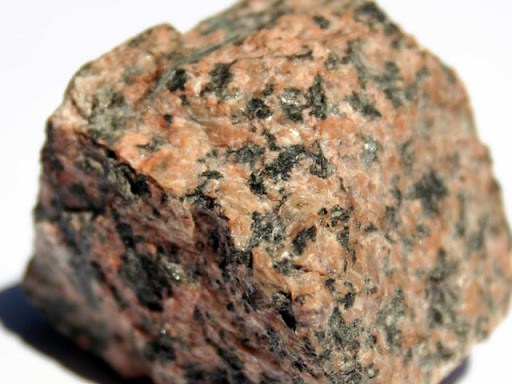
Il colore è molto variabile e legato principalmente al colore del feldspato e al contenuto dei minerali femici: bianco, giallo, rosa, rosso, bruno e verde.
Il “Granito Rosa” di colore rosa uniforme è legato alla colorazione del K-feldspato e la sua composizione mineralogica è K-feldspato, quarzo, plagioclasio, e da evidenti biotiti; fluorite, mica bianca, zeoliti, epidoto, allanite, zircone e magnetite. Viene estratto dalle cave di Baveno sul Lago Maggiore dal XIX secolo; è uno dei graniti più utilizzati per l'edilizia e la decorazione.
Ipotesi di genesi del Granito
Genesi per cristallizzazione frazionata
Esistono due teorie per la formazione del granito, la prima per “cristallizzazione frazionata” va attribuita al lento processo di cristallizzazione frazionata che avviene all'interno della camera magmatica. Tramite questa teoria è quindi possibile spiegare le varie associazioni di rocce che troviamo nei plutoni come vari stadi dell'evoluzione del magma. Le associazioni plutoniche si possono utilmente schematizzare in due categorie principali:
• Associazioni plutoniche calcalcaline
• Associazioni plutoniche a graniti dominanti
In entrambe le associazioni il granito è comunque un punto di arrivo dell'evoluzione, in quanto rappresenta la roccia più differenziata. Questa evoluzione del magma viene rappresentata ottimamente nel diagramma del sistema granitico, dove tramite un grafico ternario di SiO2, albite e ortoclasio si può seguire il percorso di differenziazione di un magma sovrassaturo.
Genesi per ultrametamorfismo
Accanto alla genesi per cristallizzazione frazionata, alcuni petrologi hanno formulato l'ipotesi della genesi per ultrametamorfismo. Questa teoria spiega la formazione del granito grazie alla fusione parziale o totale, detta anatessi, di anfiboliti e granuliti.
PER LOGGARE LA CACHE
Le risposte e i metodi di comparazione sono tutte contenute nel listing e al GZ.
Prima inviate le risposte e dopo procedete al log.
1 - Quali elementi danno la colorazione al granito? E nel caso del granito rosa quale tipo specifico?
2 - A quali profondità il magma si trasforma in granito?
3 - Poggiando una mano su una delle colonne e usando il metodo di comparazione della grana, come definiresti quest'ultima? Fine – Media – Grossa ?
4 - Sulla colonna a DESTRA dell’inizio del ponte (piu vicina alle coordinate) son presenti due evidenti grandi biotiti intrusivi neri (vedi foto per riconoscerli).
A che altezza si trovano rispettivamente A e B dal suolo?
Che dimensione approssimativa hanno?
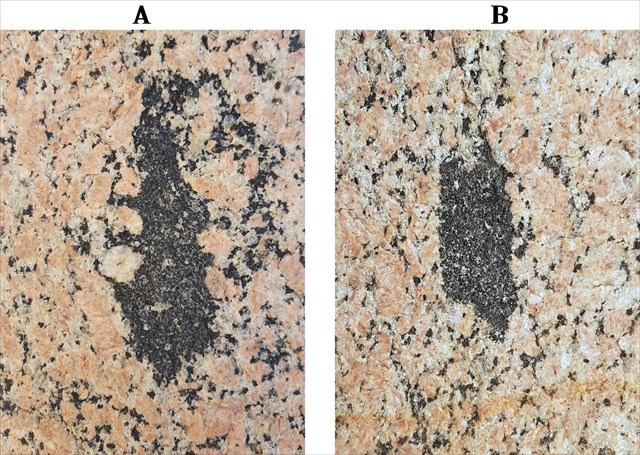
5 --RICHIESTA NON OPZIONALE- FOTO di voi con una o entrambe le colonne. (IN PRIVATO NON NEL LISTING)
(Guidelines 2019 GSA Point "6.Logging")
Log senza risposte verranno cancellati dopo 12 ore
NON verranno accettate:
- risposte scritte in lingua che non sia Italiano o Inglese!
- Write Note di alcun genere.
|


Canal Port and Byzantine Columns
The Canal Port of Cesenativo was built on a design by Leonardo da Vinci in 1502 on commission by Cesare Borgia.
At the entrance to the bridge, the two Byzantine columns in pink granite stand out, still present, accompanied by historic boats and symbols hidden behind the colored drapes of the sails. The columns date back to the short period of Venetian domination (1503-1505) and as a custom they should have held one the lion of San Marco and the second the statue of the local patron.

Photo references from Wikipedia, Forlì24ore.it, Livingcesenatico.it, Istituto italiano Edizioni Atlas
During the Renaissance the importance of the port of Cesenatico grew especially in the short period of the domination of the Serenissima Republic of Venice, when the small town became an important hub of international trade, especially with Flanders and Spain, and the columns are still today them as evidence of this incredible past of Cesenatico.

The Granite
Granite in general is one of the most abundant rocks on the earth's surface; it is a felsic intrusive igneous rock, therefore formed as a result of the slow solidification of a magma that has intruded at depths between 1.5 and 50 km. The color is very variable and mainly linked to the color of the potassium feldspar and the content of the femic minerals: white, yellow, pink, red, brown and green.
The process of granite formation, at its genesis is still under debate and has generated various hypotheses (Genesis by fractional crystallization or by ultrametamorphism) and classifications of granite (such as Alphabetical, Pitcher or Pearce classification).

It is a rock made up mostly of feldspar, quartz and micas (a group of minerals belonging to phyllosilicates) and the texture is hypidiomorphic phaneritic, from equigranular to porphyritic. In the case of the pink marble of these columns there is a good presence of intrusive xenoliths composed of femic minerals, black micas whose color is given by the presence of Iron.

The "grana"
Granite, from the Latin granum (grains), as the name suggests clearly refers to its granular or phaneritic texture. The origin of the name is attributed to Andrea Cesalpino, philosopher, botanist and university professor (1520–1603). Its grain ranges from medium (about 1 mm) to coarse (about 4 mm up) and occasionally it can have megacrystals as already mentioned black micas in the case of the pink marble of these columns. The grain is given by the fact that crystals do not form at the same time, in fact we can note that only those of feldspar and mica are well formed, silica has a higher solidification point (it crystallizes after the others) for this reason it plays a cementing and filling role, creataing this mixed, interloped material.

The color is very variable and mainly linked to the color of the feldspar and the content of the femic minerals: white, yellow, pink, red, brown and green.
The uniform pink “Pink Granite” is linked to the coloring of K-feldspar and its mineralogical composition is K-feldspar, quartz, plagioclase, and evident biotites; fluorite, white mica, zeolites, epidote, allanite, zircon and magnetite. It has been extracted from the Baveno quarries on Lake Maggiore since the 19th century; is one of the most used granites for construction and decoration.
Hypothesis of the genesis of Granite
Genesis by fractional crystallization
There are two theories for the formation of granite, the first for "fractional crystallization" is attributed to the slow process of fractional crystallization that takes place inside the magma chamber. Through this theory it is therefore possible to explain the various associations of rocks that we find in plutons as various stages of magma evolution. Plutonic associations can be usefully summarized in two main categories:
• Calcalcaline plutonic associations
• Plutonic associations with dominant granites
In both associations the granite is however a point of arrival of evolution, as it represents the most differentiated rock. This evolution of the magma is best represented in the diagram of the granite system, where through a ternary graph of SiO2, albite and orthoclase it is possible to follow the differentiation path of an oversaturated magma.
Genesis for ultrametamorphism
Alongside the genesis by fractional crystallization, some petrologists have formulated the hypothesis of the genesis by ultrametamorphism. This theory explains the formation of granite thanks to the partial or total fusion, called anathexis, of amphibolites and granulites.
TO LOGGING IN CACHE
All answers and comparision method are in lising and at GZ
Please first send the answers and then proceed to log.
1 - Which elements gives granite color? And in the case of pink granite which in particular?
2 - At what depth does intrusive magma turn into granite?
3 - Placing a hand on one of the and using the comparision method for the grain in listin, how would you define the grain? Fine - Medium - Coarse? (check listing for comparision way)
4 - On the RIGHT column at the beginning of the bridge (closest to the coordinates) there are two evident big black intrusive biotites (see photo to recognize them).
At what height are A and B respectively above the ground?
What approximate size are they?

5 - -NOT OPTIONAL REQUEST- PHOTO of you with one or both columns. (IN PRIVATE NOT IN LISTING)
(Guidelines 2019 GSA Point "6.Logging")
Logs without replies will be deleted after 12 hours
Will NOT be accepted:
- answers written in a language other than Italian or English!
- Write Notes of any kind.
|